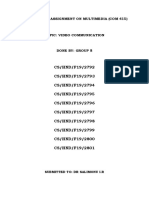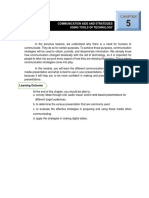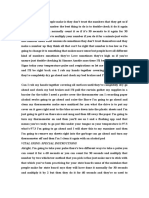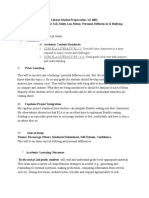New Technology For Presentations A. Computer Technology
New Technology For Presentations A. Computer Technology
Uploaded by
CicinCopyright:
Available Formats
New Technology For Presentations A. Computer Technology
New Technology For Presentations A. Computer Technology
Uploaded by
CicinOriginal Title
Copyright
Available Formats
Share this document
Did you find this document useful?
Is this content inappropriate?
Copyright:
Available Formats
New Technology For Presentations A. Computer Technology
New Technology For Presentations A. Computer Technology
Uploaded by
CicinCopyright:
Available Formats
Name : Cicin Yaena Ceria Lase
Class/Semester : A/II
Subject : Speaking For Formal Interaction
Lecturer : Mr. Hasrat Sozanolo Harefa, M.Pd
New Technology for Presentations
A. Computer Technology
The advances in computer technology is help us to presentation used technology. We can
easily merge photos, sound, and video into a presentation on computer and project it directly from
the computer onto a screen.
Here are some current technologies for creating slides and graphics:
a. Computers
b. Scanners
c. Computer Projectors
B. Using Presentation Software
a. When slides help
Slides can add significant improvements to the persuasiveness of a presentation. They are
especially effective for:
Focusing our audience’s attention
Stimulating interest
Reinforcing key ideas or data
Illustrating hard-to-understand points
Increasing audience retention of our content
b. When they don’t
Slides will detract from presentation if:
Used primarily to avoid audience interaction
They contain overwhelming amounts of detail
Slide content and/or sequencing containts too many points or no point at all
The speaker reads the slides rather than uses them as supporting material
C. 15 Tips For Creating Better Slides with Presentation Software
1. Allow an average of two minute per slide
2. Put your titles to work
3. Use the “5X5” guideline
4. Use phrases and key words
5. Capitalize only the first letter
6. Don’t “build” every slide
7. Number every slide
8. Adhere to color scheme or style guidelines
9. Consider using sans serif fonts
10. Use a 24 point font size
11. Pictures, photographs, and video clips
12. Use clip art sparingly
13. Animating drawings
14. Have backups
15. Remember
D. Teleconferencing and Videoconferencing
Advantages and Disadvantages
It helps to acknowledge in advance that a conference call, or even a videoconferencing the
limitations and building on the strengths can help those involved use the tools most effectively.
What are the disadvantages?
Conference calls:
Participiant’s attention wanders because there is no visual element.
The voice is the only “involvement” technique-there’s no opportunity for non-verbal
communication.
“Speaker phone” Syndrome.
Poor Phone etiquette.
Videoconferences :
Equipment is not used to the best advantage.
Unrealistic expectations of clear communications.
What are the advantages?
Cost savings : many, many thousands of dollars in travel costs can be saved.
Time savings : a conference call is often taken right at our work station.
Teamwork : while budgets and time may allow for only one or two people to
travel to another site, in a conference call or videoconference, more people can be
involved.
E. Get Ready, Get Set, Go!
The following suggestions for before, during and after a conference will help us to make the
most of the tools available.
Before
1. Analyze the audience.
2. Develop a plan.
3. Send information out in advance.
4. Make assignments in advance.
5. Be aware of the limitations.
6. Develop some ground rules in advance.
During
1. Remember the power of an attention – grabbing introduction.
2. Stick with the agenda you have designed.
3. Use your voice!
4. Take the temperature of the group periodically.
5. Allow time for feedback.
After
Follow up! Talk to people at the other sites and get their feedback as to how the conference
could have been made more effective. And establish a system to check on action items before
the next conference.
You might also like
- Name: Krisnawati Telaumbanua Class/ Semester: A/2 Subject: Speaking For Formal InteractionDocument4 pagesName: Krisnawati Telaumbanua Class/ Semester: A/2 Subject: Speaking For Formal InteractionCicinNo ratings yet
- Part 4 New Technology For Presentations Computer TechnologyDocument3 pagesPart 4 New Technology For Presentations Computer TechnologyCicinNo ratings yet
- Public Speaking & Oral ReportingDocument29 pagesPublic Speaking & Oral ReportingAnuruddha RajasuriyaNo ratings yet
- PBI1102AE1 - Module LU3 - PartcDocument10 pagesPBI1102AE1 - Module LU3 - PartcJeffery UbamNo ratings yet
- Oral Presentation and Powerpoint: Printer-Friendly VersionDocument9 pagesOral Presentation and Powerpoint: Printer-Friendly Versionlie-aNo ratings yet
- Chapter 6 COMMUNICATION AND STRATEGIES USING TOOLS OF TECHNOLOGYDocument6 pagesChapter 6 COMMUNICATION AND STRATEGIES USING TOOLS OF TECHNOLOGYChaikaNo ratings yet
- 12 Elements of A Successful PresentationDocument4 pages12 Elements of A Successful PresentationPreethi JohnNo ratings yet
- Importance of The Usage of Technology To CommunicationDocument5 pagesImportance of The Usage of Technology To CommunicationTon TayrusNo ratings yet
- BCommManagers 09Document41 pagesBCommManagers 09Muhammad Wali UllahNo ratings yet
- Microsoft Powerpoint 2007 Basics: Email: Training@Ufl - Edu Web Site: Http://Training - Health.Ufl - EduDocument26 pagesMicrosoft Powerpoint 2007 Basics: Email: Training@Ufl - Edu Web Site: Http://Training - Health.Ufl - EduMed AsbanNo ratings yet
- Chapter 6 Communication and Strategies Using Tools of TechnologyDocument5 pagesChapter 6 Communication and Strategies Using Tools of TechnologyAimee PabloNo ratings yet
- Creative Technology Q1 Lesson 1 Week 1-Jamisola - FUNDAMENTALS OF DYNAMIC COMPUTER DYNAMIC DESIGN - DoneDocument9 pagesCreative Technology Q1 Lesson 1 Week 1-Jamisola - FUNDAMENTALS OF DYNAMIC COMPUTER DYNAMIC DESIGN - Donehdumpy864No ratings yet
- GE2 FinalDocument21 pagesGE2 FinalVi Marie De LeonNo ratings yet
- Module 5 Purposive CommunicationDocument14 pagesModule 5 Purposive CommunicationUngos SheenaNo ratings yet
- Creative Technology Q1 L W1 JamisolaDocument11 pagesCreative Technology Q1 L W1 JamisolaBlas MantesNo ratings yet
- Medium of Presentation ReloadedDocument7 pagesMedium of Presentation ReloadedAnand JanardhananNo ratings yet
- TrainingDocument31 pagesTrainingAnubha JainNo ratings yet
- Purposive Communication: Instructress: Lyn B. AyopDocument25 pagesPurposive Communication: Instructress: Lyn B. AyopAlmavilla BantayanNo ratings yet
- FGHFGDocument3 pagesFGHFGcloui sjNo ratings yet
- Guidelines For Oral PresentationsDocument9 pagesGuidelines For Oral PresentationsRomulo EstreraNo ratings yet
- Lesson 5 COMMUNICATION AIDS AND STRATEGIES USING TOOLS OF TECHNOLOGYfinalDocument28 pagesLesson 5 COMMUNICATION AIDS AND STRATEGIES USING TOOLS OF TECHNOLOGYfinaljeanetteanneborje0No ratings yet
- UNIT 1 Lesson 7 Communication Aids and StrategiesDocument13 pagesUNIT 1 Lesson 7 Communication Aids and StrategiesAngelica TalandronNo ratings yet
- Oral Presentation and PowerpointDocument6 pagesOral Presentation and PowerpointDaniel Camilo CanoNo ratings yet
- Tradeshow and Training 2. Defining The Target Audience. 3. Story Boarding: Planning The Flow 4. Maintaining Focus and InterestDocument14 pagesTradeshow and Training 2. Defining The Target Audience. 3. Story Boarding: Planning The Flow 4. Maintaining Focus and InterestNuraini AiniNo ratings yet
- Chapter 5Document7 pagesChapter 5Justin DamasoNo ratings yet
- SLIDESDocument7 pagesSLIDEShashmatamin9No ratings yet
- OUTLINEDocument8 pagesOUTLINEFaithlyn Riche YocorNo ratings yet
- Preparing The Day of Your SessionDocument2 pagesPreparing The Day of Your SessionUduebor MichealNo ratings yet
- Microsoft Excel FormulaDocument2 pagesMicrosoft Excel Formulazephyr.dryst143No ratings yet
- 201 Work Group TechnologiesDocument40 pages201 Work Group TechnologiesVinay AroraNo ratings yet
- Mobile Guide Creating An Engaging Webcast ExpandedDocument16 pagesMobile Guide Creating An Engaging Webcast ExpandedgdhtraiteurNo ratings yet
- 08 Visual AidsDocument4 pages08 Visual AidsJosh KempNo ratings yet
- Problems Using Projector in ClassroomDocument6 pagesProblems Using Projector in Classroomrhina56789No ratings yet
- Presentaciones Efectivas Module 1 Introduction To Effective Presentations Topic 5 Audiovisual ToolsDocument7 pagesPresentaciones Efectivas Module 1 Introduction To Effective Presentations Topic 5 Audiovisual ToolsFery VillarrealNo ratings yet
- A Review of A de TechnologyDocument8 pagesA Review of A de TechnologyAminaNo ratings yet
- Important Parameters of CommunicationDocument32 pagesImportant Parameters of CommunicationTarun KumarNo ratings yet
- (Using Presentation Aids) Team 10Document10 pages(Using Presentation Aids) Team 10kkkkkkkNo ratings yet
- Lecture 6 - Communication and Strategies Using Tools of TechnologyDocument25 pagesLecture 6 - Communication and Strategies Using Tools of TechnologyNicole Novesteras100% (1)
- Assignment On MultimediaDocument4 pagesAssignment On MultimediaOlawore muideenNo ratings yet
- Module - 6Document57 pagesModule - 6Akshitha KulalNo ratings yet
- Communication Aids and Strategies Using Tools of TechnologyDocument6 pagesCommunication Aids and Strategies Using Tools of TechnologyAquino, Crizen Cyla U.No ratings yet
- Developing Oral and Online PresentationsDocument25 pagesDeveloping Oral and Online PresentationsRifqiApriansyahNo ratings yet
- ASHRAE Speakers Manual: Preparation of Visual AidsDocument5 pagesASHRAE Speakers Manual: Preparation of Visual AidsaryasusuNo ratings yet
- Enhancing Presentations With Slides and Other VisualsDocument8 pagesEnhancing Presentations With Slides and Other VisualsAditya MayankNo ratings yet
- 2.6.1 Oral Presentation ObstaclesDocument9 pages2.6.1 Oral Presentation ObstaclesClaraNo ratings yet
- JTW 106E JUW 106E Chapter 17 April 20 2018Document24 pagesJTW 106E JUW 106E Chapter 17 April 20 2018Nhirrmal VejayandaranNo ratings yet
- Week 2 Day 1 English 7Document5 pagesWeek 2 Day 1 English 7Vergel Bacares BerdanNo ratings yet
- PMOne Newsletter - German PugliaDocument1 pagePMOne Newsletter - German PugliaDon PugliaNo ratings yet
- SAQA - 115374 - Learner GuideDocument25 pagesSAQA - 115374 - Learner GuidenkonemamakiNo ratings yet
- Visual PresentationDocument4 pagesVisual PresentationBilalNo ratings yet
- HUM102 Handouts Lecture21 PDFDocument10 pagesHUM102 Handouts Lecture21 PDFWahaj ShahNo ratings yet
- Instructional AidsDocument5 pagesInstructional AidsPraba RajamanickamNo ratings yet
- Business Presentation ProjectDocument4 pagesBusiness Presentation Projectapi-238932241No ratings yet
- JTW 106e Juw 106e Chapter 17Document26 pagesJTW 106e Juw 106e Chapter 17heryatiesNo ratings yet
- Presentation Skills 1Document27 pagesPresentation Skills 1kimmijain2002No ratings yet
- Ict G5 30-04-20Document3 pagesIct G5 30-04-20joelNo ratings yet
- EFC 1 Module 9Document16 pagesEFC 1 Module 9Denni MuharamNo ratings yet
- Assignment 2 KTTC Employability SkillsDocument5 pagesAssignment 2 KTTC Employability SkillsDante MutzNo ratings yet
- Executive Summary of The Exceptional Presenter Goes Virtual: Lead Dynamic Online MeetingsFrom EverandExecutive Summary of The Exceptional Presenter Goes Virtual: Lead Dynamic Online MeetingsNo ratings yet
- Pitch to Win: The Tools That Help Startups and Corporate Innovation Teams Script, Design, and Deliver Winning PitchesFrom EverandPitch to Win: The Tools That Help Startups and Corporate Innovation Teams Script, Design, and Deliver Winning PitchesNo ratings yet
- Lesson PlanDocument8 pagesLesson PlanCicinNo ratings yet
- Vital Signs Temperature, Pulse and RespirationDocument6 pagesVital Signs Temperature, Pulse and RespirationCicinNo ratings yet
- Cover Rekayasa Ide - ReadingDocument3 pagesCover Rekayasa Ide - ReadingCicin100% (1)
- Cicin's Contents VideoDocument7 pagesCicin's Contents VideoCicinNo ratings yet
- REKAYASA IDE - Id.enDocument14 pagesREKAYASA IDE - Id.enCicinNo ratings yet
- Adjective MeaningDocument13 pagesAdjective MeaningCicinNo ratings yet
- Erwin SpeakingDocument2 pagesErwin SpeakingCicinNo ratings yet
- Types of MeaningDocument1 pageTypes of MeaningCicinNo ratings yet
- 个人陈述开篇Document11 pages个人陈述开篇afodefcwbtuyfw100% (1)
- Erg QRC MemoDocument2 pagesErg QRC MemoMike SimonsNo ratings yet
- Paraphrasing ReferencingDocument35 pagesParaphrasing Referencingusman-bin-arshad-5275100% (1)
- 00 Writing B1 Presentation FullDocument61 pages00 Writing B1 Presentation FullMónica Antelo BarralNo ratings yet
- Real VampyresDocument1 pageReal VampyresAyden TolsenNo ratings yet
- Viewpoint 1 General Quiz Unit 4Document3 pagesViewpoint 1 General Quiz Unit 4elena jakuNo ratings yet
- TOEFL TEST 3 (Dragged) (Dragged)Document3 pagesTOEFL TEST 3 (Dragged) (Dragged)admrawatinaprsgNo ratings yet
- Best Practice Vs Best FitDocument2 pagesBest Practice Vs Best FitPendi Yaakub50% (2)
- The Socio-Cultural Context of The Household Family Compound (Agboile) Feature Among The Yoruba States in Nigeria From Social Religious PerspectiveDocument5 pagesThe Socio-Cultural Context of The Household Family Compound (Agboile) Feature Among The Yoruba States in Nigeria From Social Religious PerspectiveInternational Journal of Innovative Science and Research TechnologyNo ratings yet
- Torsten Husén A Co-Founder and Chairman of IEA From 1962 To 1978Document15 pagesTorsten Husén A Co-Founder and Chairman of IEA From 1962 To 1978Teodora GenovaNo ratings yet
- Directed WritingDocument23 pagesDirected Writingamejia3No ratings yet
- CoachStyle - Competence, Puli, SEPPDocument2 pagesCoachStyle - Competence, Puli, SEPPtgarciacalvoNo ratings yet
- 2011 - Gollwitzer, Meder & Schmitt - RevengeDocument12 pages2011 - Gollwitzer, Meder & Schmitt - RevengeGereciamento ImdbNo ratings yet
- Exponents Lesson Plan 4Document4 pagesExponents Lesson Plan 4api-317906729No ratings yet
- National Eye Institute Visual Functioning Questionnaire - 25 (VFQ-25)Document16 pagesNational Eye Institute Visual Functioning Questionnaire - 25 (VFQ-25)aryanggieNo ratings yet
- Is Female To Male As Nature Is To CultureDocument28 pagesIs Female To Male As Nature Is To CulturePăun Mihnea-DragoșNo ratings yet
- Lesson Plan Molly Lou MelonDocument4 pagesLesson Plan Molly Lou Melonapi-404491569No ratings yet
- DSK Mathematics Year 1Document38 pagesDSK Mathematics Year 1Anonymous HK3LyOqR2gNo ratings yet
- Oxford Said QuestionsDocument3 pagesOxford Said QuestionsBen LaiNo ratings yet
- Life GuaDocument11 pagesLife Gualazuli29No ratings yet
- Filipino - Re Entry Plan Isntructional SupportDocument4 pagesFilipino - Re Entry Plan Isntructional SupportDAVID TITAN JR.No ratings yet
- Assignment 2Document3 pagesAssignment 2Dorcas YanoNo ratings yet
- Practical Research 2: Identifying The Inquiry and Stating The ProblemDocument27 pagesPractical Research 2: Identifying The Inquiry and Stating The ProblemangelaNo ratings yet
- Resume Junel 1Document4 pagesResume Junel 1Jen MaramionNo ratings yet
- ChukwumaDocument13 pagesChukwumaFORTI E NDENo ratings yet
- Prospectus: The Practice of Dry Docking ShipsDocument7 pagesProspectus: The Practice of Dry Docking ShipsSunil Kumar P GNo ratings yet
- Appendix PAE-1 Career History Form (17.6.22) For WebsiteDocument1 pageAppendix PAE-1 Career History Form (17.6.22) For WebsiteizzatNo ratings yet
- Water CycleDocument6 pagesWater Cycleapi-343459926No ratings yet
- School of Our Lady of La Salette, Inc. Mt. View Subdivision, Muzon, City of San Jose Del Monte, BulacanDocument4 pagesSchool of Our Lady of La Salette, Inc. Mt. View Subdivision, Muzon, City of San Jose Del Monte, Bulacanvaughn jayNo ratings yet
- Educ 104 NotesDocument10 pagesEduc 104 Notesangelica barruelaNo ratings yet

































































































